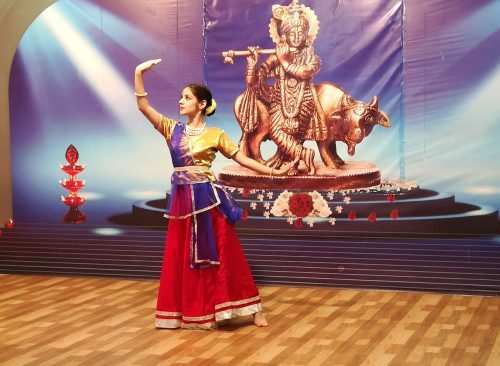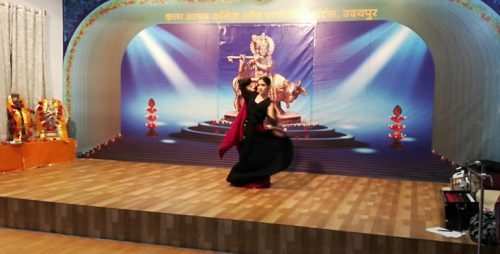A Migratory Bird – From Ballet to Kathak, Argentina to Udaipur
It is sheer delight to see someone dancing ballet. It is a splendor to watch someone dancing Kathak. But what if you see someone who pulls off both, and with

It is sheer delight to see someone dancing ballet. It is a splendor to watch someone dancing Kathak. But what if you see someone who pulls off both, and with equal poise?
“Ballet is good, because it makes you stand up tall.” The wise words of Carine Roitfeld do not come out from her lips but are uttered loud from her eyes. Maria Melissa De Angelis from Argentina has been here for over 25 days now and she is as happily lost in the gyrations and mathematics of Kathak as she has been for 15 years pirouetting and mastering the perfect Plie and Arabesque in Ballet in Argentina.
What she has learnt speaks more loudly and resoundingly as students from the city watch her recreate what she has learnt in both the genres. As she floats like a fairy swishing her skirt with unbelievable flair, the surprise-filled sighs and applause that pour out, as if on a reflex, translate Erol Ozan’s words into reality – Yes, dancing is creating a sculpture that is visible only for a moment.
But Maria is not going to be done with a ‘moment’. And that is why she chose to travel so many miles; and parked her hopes, and shoes, at this sanctuary of classical dance in our city. She arrived at the Kala Ashram College of Performing Arts, Udaipur in November and has never sat still since then. She has been stretching herself diligently on all the intricacies of Kathak and has been trying to soak up as much as she can. “It has always been riveting for me to watch Kathak. It transports the viewers to the same trance and surreal places that Ballet does back there. The velocity, the detail, the meticulous movements – all these pulled me like strong magnets.”
And of course, she left no stone, or spin, untouched when she started this journey. Under the wings and thorough mentoring of the city’s own Kathak legend Dr. Saroj Sharma (who is also the Director, Kala Ashram College of Performing Arts, Udaipur that had organized this unique cultural symbiosis this year), Maria learnt the dance – and more than superficially. She and her Guru made sure that despite the constraint of time, the dance and its spirit, could be captured in as much depth and with as much practice, as is possible by an inveterate dancer devoted to studying dance to the core.

One is tempted to ask Maria even then – surely, it must not have been easy? Coming from a universe of Barre, Cabriole, Fouette, Glissade, Maneges, Croise, Efface etc., what difficulties or similarities did she observe in this special journey? She looks at her Guru Dr. Saroj with admiration before she lets on, “Of course, every dance form is different. But all dance forms have common denominators too. It took me some time to master the syntax of Taals and some peculiar spins that work in Kathak predominantly. At the same time, these dances emphasize the posture of the body, the up-ward chin, the firm and specific elbow-stance and the overall carriage of the body in a surprisingly-similar degree of strength and detail.”
She also notes that the way stories are told through Kathak reminded her strongly of how Opera narratives spellbind ballet-watchers all over the world too. “A dance in this form too is so much about telling a narrative. Dance is just a medium for some other purpose. That’s mind blowing.”
Turn to her Guru who is as much of a dedicated teacher as she is an accomplished (and celebrated) artist internationally now. Dr. Saroj agrees that cultural exchanges help us explore that dance is, ultimately, a universal language. “It is a therapy in itself. When music, body’s posture, body’s rhythm, the mind, the spirit, and everything else aligns with the instruments played along as well as with the dance’s own graph, it is a delight to watch a person transcending into a no-stress, no-thought zone. It is strange to believe but it happens.” Indeed, good dance never happens on the ground, but in the air.
Dr. Saroj also distills other similarities – like emphasis on posture and discipline – that are inevitable and non-negotiable when one is learning Kathak. She resonates with what Anna Paskevska said about Ballet. “Learning ballet is wonderful for children even if they never become dancers. It is wonderful because it teaches discipline, grace, and manners.”
When Maria performed Kathak and taught some Ballet moves at the final day of her journey, these words manifested into reality. The workshop culminated into a performance-lit ‘Indo-Western Cultural Integration Program’ at the Kala Ashram College of Performing Arts. Here, when everyone saw how easy and effortless it looks to glide in ballet or spin in Kathak, they all could agree with what Agnes De Mille thought of Ballet. “It never becomes easy; it becomes possible.”
That’s what Maria would need next, as she embarks on the next frontier of her journey. She wants to push the boundaries of historical dances and explore more about freedom, expression and creative experimentation in her own space. And she wishes to learn more Kathak, of course.
Wishing this bird more skies until she visits us next season.
To join us on Facebook Click Here and Subscribe to UdaipurTimes Broadcast channels on GoogleNews | Telegram | Signal


